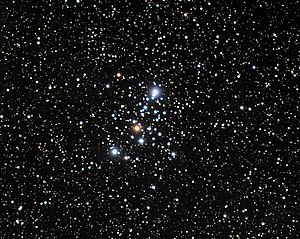
Back Messier 103 Afrikaans مسييه 103 Arabic NGC 581 Azerbaijani M103 (аб’ект Месье) Byelorussian M103 BE-X-OLD M103 Bulgarian Messier 103 BS Messier 103 Catalan NGC 581 CE M103 Corsican
| Messier 103 | |
|---|---|
 Open cluster Messier 103 in Cassiopeia | |
| Observation data (J2000.0 epoch) | |
| Right ascension | 01h 33.2m |
| Declination | +60° 42′ |
| Distance | 9,400 light-years (2.884 ± 0.313 kpc[1]) |
| Apparent magnitude (V) | 7.4[2] |
| Apparent dimensions (V) | 6.0' |
| Physical characteristics | |
| Estimated age | 12.6 ± 0.2 million years[1] |
| Other designations | NGC 581, Cr 14 |
| Associations | |
Messier 103 (also known as M103, or NGC 581) is a small open cluster of many faint stars in Cassiopeia. It was discovered on 27 March 1781 by Pierre Méchain, but later added as Charles Messier's last deep-sky object in his catalogue.[3]
It is located 9,400 light-years from the Sun[1][3] and is about 15 light years across. It holds two prominent stars, of which the brightest is magnitude 10.5, and in the center of the cluster, another magnitude 10.8 red giant. Another bright foreground object is the double star Struve 131,[4] but is not a member of the cluster. Cluster membership is about 172 stars based on >50% probability of gravitational attachment that binds the cluster together.[4] M103 is between 12.6[1] to 25 million years[5] in age.
- ^ a b c d Sanner, J.; Geffert, M.; Brunzendorf, J.; Schmoll, J. (1999). "Photometric and kinematic studies of open star clusters. I. NGC 581 (M 103)". Astronomy and Astrophysics. 349: 448–456. arXiv:astro-ph/9908059. Bibcode:1999A&A...349..448S.
- ^ "Messier 103". SEDS Messier Catalog. Retrieved 30 April 2022.
- ^ a b Robert Bruce Thompson [1], M103 (open cluster in Cassiopeia). Accessed online 13 April 2011
- ^ a b "Messier 103: Observations and Descriptions". SEDS. Retrieved 13 April 2011.
- ^ Huang, W; Gies, D.R.; McSwain, M.V. (2010). "A stellar rotation census of B stars: from ZAMS to TAMS". Astrophysical Journal. 722: 605–619. arXiv:1008.1761. Bibcode:2010ApJ...722..605H. doi:10.1088/0004-637X/722/1/605. S2CID 118532653.
© MMXXIII Rich X Search. We shall prevail. All rights reserved. Rich X Search